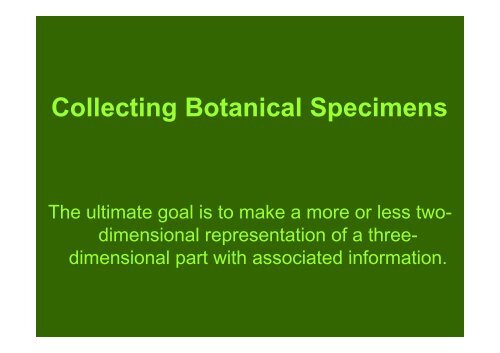Herbarium techniques
Herbarium techniques
Herbarium techniques
You also want an ePaper? Increase the reach of your titles
YUMPU automatically turns print PDFs into web optimized ePapers that Google loves.
Collecting Botanical Specimens<br />
The ultimate goal is to make a more or less two-<br />
dimensional representation of a three-<br />
dimensional part with associated information.
Stages of collecting<br />
• Preparation<br />
– Visas, ,p permits, equipment<br />
• Collecting specimens<br />
– Collection, tagging, field pressing etc.<br />
• Recording data<br />
– Label production<br />
• Specimen processing<br />
– Drying or alcohol<br />
– <strong>Herbarium</strong> incorporation
Equipment<br />
• Collecting tools:<br />
– Secateurs, machete, pruning saw, trowel<br />
• Field press<br />
– Newspapers, cardboards, d string<br />
• Plastic bags<br />
– All sizes, especially large<br />
• Tags<br />
•Data<br />
– Notebook, GPS, altimeter
The perfect botanist?<br />
• Hand lens<br />
• Binoculars<br />
• Secateurs<br />
•GPS<br />
• Field press<br />
• And of course….<br />
leech socks
What to collect:<br />
• What will represent the plant?<br />
• Samples of all organs available<br />
• At least two sets (=duplicates)<br />
• Large plants<br />
– Complete notes<br />
– Complete parts<br />
• All sizes – not tjust t‘ ‘easy’ ones<br />
•Only one taxon per number
Field pressing<br />
Making notes<br />
Writing tags<br />
Field press<br />
Trimming<br />
specimens
Numbering specimens<br />
• Each collection is numbered<br />
• Number allows label to be assigned<br />
– Tag each part with the number<br />
• Use each number only once<br />
– A running sequence is easiest<br />
• Use pencil on the tags<br />
– Does not come off in alcohol<br />
l
Tags:<br />
• Use pencil<br />
• Every set<br />
• Every part
Recording data<br />
• Data for labels<br />
• Specimen = collection + label<br />
– Without the label the specimen is useless<br />
•Part of the collecting trip<br />
– Collector’s responsibility to write up label data<br />
– Send it to the collaborating institute
The minimum data<br />
• Locality including the country<br />
• Habitat<br />
• Altitude<br />
• Field identification<br />
• Collector’s name and number<br />
• Date of collection<br />
• ?Plant description
Full data<br />
• GPS data<br />
• Geology<br />
• Plant description<br />
– Habit, sizes, colours, smells, textures<br />
• Project data<br />
– <strong>Herbarium</strong> and collaborator information<br />
• Local names (check reliability!)<br />
•Uses
Habit<br />
• Size: height and diameter at breast height<br />
(dbh)<br />
• Slash<br />
• Exudate: thickness, colour, smell<br />
•Thorns or spines<br />
• Buttresses?<br />
• Shape in cross section
Leaves<br />
• Deciduous or evergreen<br />
• Texture<br />
• Exudate or glands<br />
• Orientation: hanging, erect etc.<br />
• Large (measure in the field)<br />
• Heterophyllous:<br />
– Young leaves a different colour?
• Position:<br />
Inflorescence & flowers<br />
– Axillary, cauliflorous<br />
• Scent<br />
• Colour<br />
• Sexuality:<br />
– Hermaphrodite, dioecious<br />
– Different sexes, different plant = new number<br />
• Pollinators (or floral visitors)
Fruit and seeds<br />
• Colour<br />
• Texture<br />
• Size, shape,<br />
– especially fleshy fruits which will shrink<br />
– measure and record size when fresh<br />
• Aril colour, texture<br />
• Dispersal agents?
Label examples
Specimen processing<br />
• In the tropics most plants will grow mould<br />
within several days if not dried sufficiently.<br />
• Drying in the field or field station<br />
– dried specimens keep their colour<br />
– do not become as brittle as alcohol<br />
specimens<br />
• Preserving with alcohol<br />
– Useful when travelling around a lot<br />
– Less equipment needed
The alcohol method<br />
• Also called the Schweinfurth method<br />
• Specimens placed within newspapers<br />
• A good sized bundle is put in a bag<br />
• Alcohol added<br />
• Bag sealed<br />
• Specimens stored up to c. 3-4 months<br />
• Specimen pressed and dried later
Drying specimens<br />
• In the field or after alcohol l processing<br />
• Alternate layers of:<br />
cardboard<br />
corrugate<br />
specimen<br />
cardboard<br />
corrugate<br />
specimen….
Drying contd.<br />
• Gentle heat for c. 2 days (max 4 days)<br />
• E.g., in an oven or over a gas burner

















